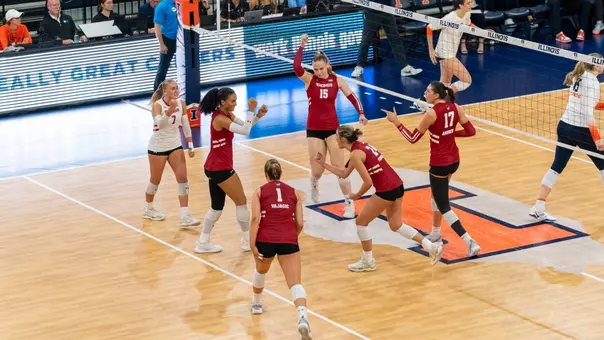
Badger Block!
October 21, 2011 | Volleyball
Oct. 21, 2011
“Anticipation, foot speed, quick hands, good vertical jump and a relentless attitude.”
No, we’re not talking about a wide receiver in football. According to coach Pete Waite, we’re talking about what it takes to be a good middle blocker.
“Blocking is tougher than fans think because every set is in a slightly different spot, every set is a different speed, every attacker has different strengths and weaknesses, and the best players have shots all over the place,” explains Waite.
The Badgers must be doing something right this season as they currently rank 36th nationally with 2.55 blocks per set. Wisconsin averaged just 1.86 blocks per set in 2010, an improvement of 0.69 blocks per set this season.
“We’ve been working hard for a long time on our blocking and some of the players are starting to make some real changes in their technique and their discipline,” explains Waite. “And it’s starting to show up. And when it shows up and they get some positive results, they’re more hungry for it. It’s really making a difference in our overall defensive play and our schemes.”
| "Blocking is tougher than fans think because every set is in a slightly different spot, every set is a different speed, every attacker has different strengths and weaknesses, and the best players have shots all over the place." Coach Pete Waite |
Good blocking has a variety of benefits. It can stymie an opponent’s offense, but it also helps your own team’s back-row defense.
“It helps our defense when we block better as well so that’s what we’ve been focusing on as middles – to help our defenders,” said sophomore Dominique Thompson, who ranks second on the team with 62 total blocks or 0.94 per set.
Waite agrees, “Even a nice deflection is a good block. It doesn’t have to be a stuff block. If we can slow it down and then can transition with it, then it’s an excellent block.”
Wisconsin’s block has allowed the Badgers’ back-row defense to average 16.05 digs per set this season, which leads all Big Ten teams.
Things to look for in a good team block are no gaps between blockers, no large spaces between the blocker’s hands and that each blocker presses their hands across the plane of the net.
“Our footwork has gotten a lot better in closing the block, we’ve been working hard with that, and also pushing over with our hands,” says Thompson.
Both Thompson and UW’s other starting middle blocker Alexis Mitchell have improved their technique greatly this year, according to Waite. “Alexis realized last spring just how hard you have to work as a middle blocker but now she’s getting much better with her hands and where she’s putting them, as is Dom.”
Mitchell leads the Badgers with 74 total blocks and ranks eighth in Big Ten-only matches with 1.12 blocks per set.
“We’re really focusing on blocking—closing gaps and forming a sealed block,” says Mitchell. “I think it has really helped my overall game. I’m contributing more the whole time I’m on the court. I can contribute to the team when I’m not having a great night hitting and it feels great!”
“You have to be quick to be able to see what’s happening and react well but you also have to be patient and make sure you don’t guess,” explains Thompson. “You also have to make sure you stay disciplined with your block and focus on what you need to do.”
So how does a block compare to a kill for the Badgers?
“I really like getting blocks a lot better,” says Mitchell. “You’re shutting down that hitter, taking someone out of the game. I think we’ve done a great job of holding down other team’s hitting percentage. It also makes teams think twice about where they’re hitting.”
“Nothing compares to getting a really good block, nothing compares,” says Thompson with a smile. “It’s awesome!”













